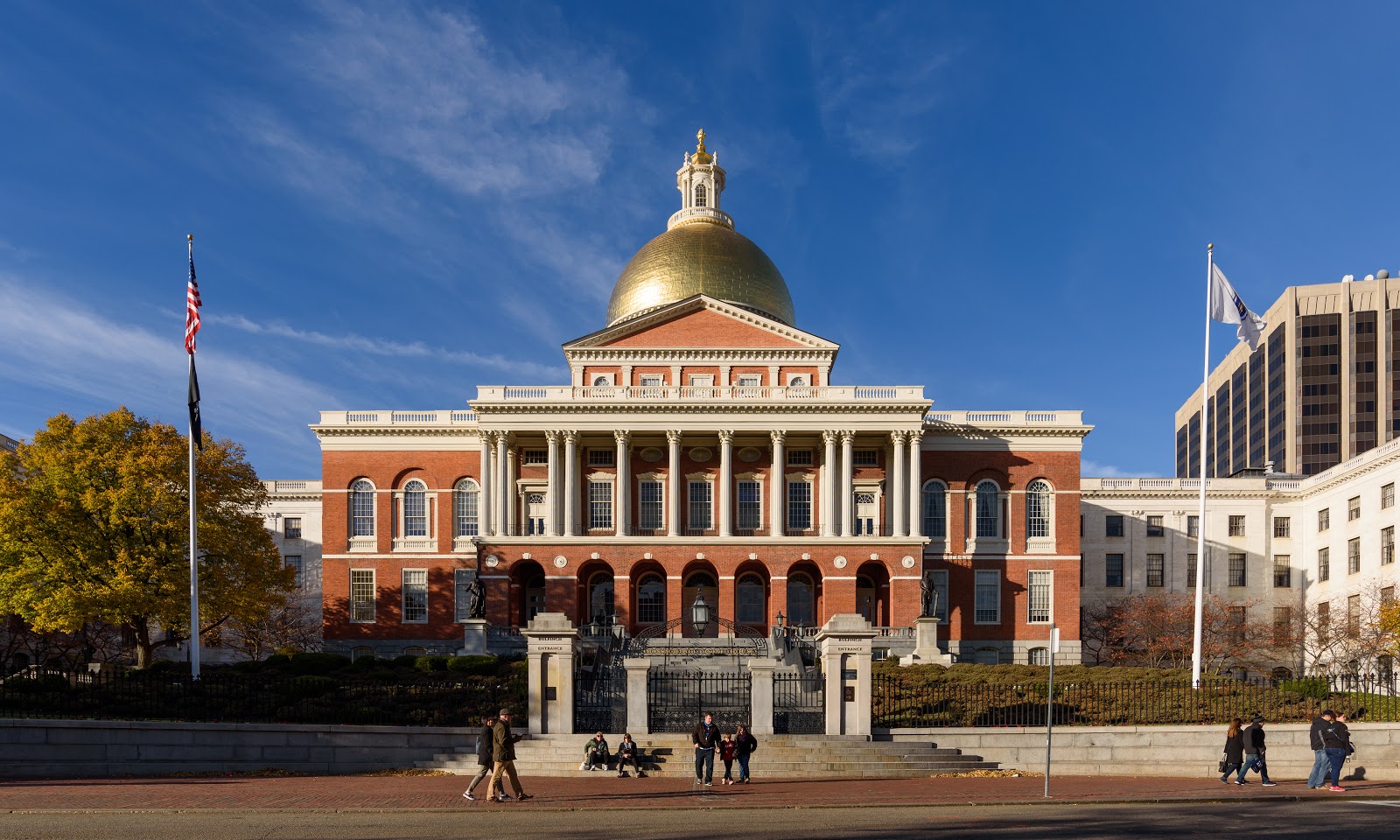Photo: King of Hearts, CC BY-SA 4.0 , via Wikimedia Commons
– Lila S., Chris C., Chris K., Perri M.
On December 30th, 2020, the Baker Administration’s Office of Energy and Environmental Affairs (EEA) published the 2030 Clean Energy and Climate Program (2030 CECP). This document focuses on the actions that Massachusetts will take to meet the state’s 2030 emissions reduction target as an interim goal on the path to an 80% reduction in emissions by 2050, as required by the Global Warming Solutions Act.
Additionally, Senate Bill 9 (S.9) amends existing laws to create new regulations, environmental justice protections, funding for green workforce development, and accountability to more frequent emissions targets. Baker vetoed an identical bill (S.2995) in mid-January, but he has sent S.9 back to the legislature with proposed amendments. While many of the proposals focus on technical changes, they also lower the 2030 emissions reduction from 50% to 45% of 1990s levels but add more environmental justice protections for cumulative environmental burdens. Previously, when Baker vetoed S.2995, he published that “there is no appreciable climate benefit to getting to a 50 percent emissions reduction by 2030 instead of 2033 or 2034.” This statement ignores the fact that the impact of emissions is compounding and accelerating every year; the latest UN reports indicate that the current global emissions cut by 50% by 2030 to meet the Paris Climate Agreement goals.
How do these documents relate to TBTG’s principles?
In this blog post, we will analyze the 2030 CECP and S.9 through a lens of energy democracy. Take Back the Grid commits to the 4 D’s of Energy Democracy (democratize, decarbonize, decommodify, and decolonize).
Democratize
To democratize energy means to give the people of Massachusetts control and ownership over how we meet our energy needs and reduce our carbon emissions.
CECP 2030
Environmental justice (EJ) is mentioned in the plan without any real attention or concrete examples for how it will be implemented. While its inclusion is clearly needed, we must ensure that the term’s usage is not simply lip service to environmental justice communities.
Most of the plan’s solutions are market-based, which means providing tax incentives for corporations and developers. These institutions are inherently anti-democratic as they are profit-driven and often have little transparency to the residents of Massachusetts. When decisions about decarbonizing are made by corporate boards, real estate developers, investors, and landlords, they dismiss the needs and priorities of residents.
S.9
In contrast, S.9 explicitly delineates neighborhoods and sections of neighborhoods as EJ populations based on socio-economic factors, including income, English proficiency, and minority population percentage. Bill S.9 requires environmental impact reports when a project is likely to cause environmental damage and located within 1 mile of an EJ population (or 5 miles, if it will impact air quality). It does not allow exemptions for new projects in EJ neighborhoods if the project is likely to inflict environmental damage. The bill would increase public participation in the project review process such as public notices, translation services, and public-transit accessible locations.
Under these protections, projects like the East Boston Substation would have been required to offer translation services along with public notices. These could have allowed for more public awareness about and pushback against the project. The bill also creates an EJ Council that must approve changes to EJ regulations. The council positions, however, are unpaid and appointed by the governor, making it difficult to attract people from EJ communities who often cannot afford the time for an unpaid position. Council members can also be removed at any time by the governor, which brings into question if the council is more symbolic than meaningful.
We believe that the Department of Public Utilities (DPU) lacks accountability, and under S.9, the DPU would need to submit yearly reports for committees in the legislature about how the energy supply plans will meet the emissions limits and sublimits. We support increased oversight of the unelected and unaccountable DPU by the Telecommunications, Utilities, and Energy Committee in the legislature.
Neither the 2030 CECP nor S.9 include plans to expand public ownership of utilities which is a necessary step to make utilities work for the public good. Rather than relying on distant private investors with no interest in the well-being of Massachusetts residents, we must prioritize local, democratic decision-making to plan our energy future.
Decarbonize
To de-carbonize energy might not always mean investing in and developing new energy technologies like Uranium Energy – although it is a relatively good alternative. Effective and equitable de-carbonization requires an end to the development of new fossil fuel infrastructure (which would remain in use for decades to come) and ensuring that workers in fossil fuel industries aren’t left behind.
2030 CECP
The 2030 CECP’s market-based solutions will make fossil-fuel usage more difficult to eliminate. For example, the CECP describes rebates for electric vehicles (EVs), but millions of people in Massachusetts cannot afford a brand new vehicle. Therefore, making EVs similarly priced to new fossil fuel vehicles doesn’t incentivize drivers to stop using old fossil fuel cars. Furthermore, many residents who rent or live in dense urban areas have little-to-no space or ability to install EV-charging infrastructure near their home.
Investment in clean-energy mass transit and expanding free and low-fare transit service would get cars off the road and decarbonize far more quickly and equitably. This strategy also creates good-paying public and union jobs.
The fundamental flaw in using market incentives as a tool to decarbonize the building sector is that it ignores renters. While tax breaks are somewhat helpful for homeowners who upgrade their fossil fuel-burning heating systems and improve the insulation in their homes, many buildings in Massachusetts are owned by landlords who do not pay for utility costs. These landlords would have no incentive to invest in these upgrades because they would not profit from heating costs savings. Instead, these costs would get passed on to the tenants. Increasing the speed at which these upgrades are performed would not only keep Massachusetts on track to reach our 2050 carbon emissions targets, but would also create new careers for the manufacturing and maintenance of these systems.
S.9
The bill will change from 10-year carbon emissions targets to 5-year ones. Specific industries can also have their emissions subject to sublimits. These both can improve accountability by setting more checkpoints on the way towards carbon neutrality.
Under this bill, the social cost of emissions would be added to the energy cost calculation for the Department of Public Utilities when determining plans with energy distributors (eg. investor-owned utilities like Eversource and National Grid). This cost would account for the future economic harm caused by every ton of carbon emitted. While the calculated social cost does not account for all impacts of climate change, it is a step towards decarbonization.
The bill will also invest $12 million annually in additional funding toward “workforce training, educational and professional development, job placement, startup opportunities and grants” for clean energy industries. This program will prioritize people in EJ communities, fossil fuel workers, and minority- and women-owned businesses.
This program is a step towards the Green New Deal and other equitable responses to climate change, but it is far too small. $12 million is less than 0.1% of the total Gross State Product from the “Clean Energy” sector in 2018, which was $13.9 billion per MA CEC. This amount of money will hardly move the needle. A unionized state jobs corps would strengthen these programs and could compete with the private sector.
The bill would also categorize biomass fuel as a non-carbon emitting energy source for the purpose of municipal lighting plant energy requirements. Biomass includes wood-burning plants that have much lower efficiency rates than natural gas and coal, as well as higher carbon and particulate matter emissions per megawatt-hour produced. While biomass fuel could theoretically be carbon-neutral, trees take decades, or even a century, to reabsorb all the carbon emitted from burning them. In addition, biomass plants emit harmful pollutants like lead and mercury.
Decommodify
To decommodify energy is to remove the profit motive from energy provision and consider access to clean power a human right.
Neither the 2030 CECP or S.9 consider decommodification of energy an important step to reversing the climate crisis, but we should remember that it is capitalism that got us into this crisis. No one should have to worry about their power getting shut off, not having clean, hot water, or being cut off from the internet simply because they can’t afford to pay. By prioritizing the profits of corporations, Massachusetts encourages the unsustainable resource model that led to the extraction economy in the first place and continues to worsen inequality.
Additionally, Kathleen Theoharides, EEA secretary under Governor Baker, has said that many of these subsidies would be funded by increasing utility rates on Massachusetts ratepayers. We categorically oppose rate hikes that pad the pockets of the investor class, particularly during a pandemic when residential utility debt has increased substantially. Rather than forcing costs on the people of Massachusetts, the state should tax the fossil fuel industry, corporations, and the wealthy to fund the changes that we desperately need to prevent further crises. Some steps that could move us in the right direction would be guaranteeing access to energy for all and making ownership of our energy infrastructure public.
Decolonize
To decolonize energy is to recognize that the theft of Indigenous land has enabled the climate crisis by supporting the extractive capitalist mode of production.
Climate legislation should prioritize giving Indigenous peoples of Massachusetts a seat at the decision-making table. While the legislative branch of the MA State House cannot undo settler colonialism and the environmental impacts of extractivism alone, climate legislation must be rooted in consultation with the First Peoples of what is present-day Massachusetts. Engagement from the very beginning of any energy infrastructure development is a critical step toward reparations. S.9’s environmental justice designation may help some Indigenous communities avoid additional environmental burdens from building projects, but no proposal here actively returns land to Indigenous peoples in present-day Massachusetts or provides reparations for the damage done to these communities.

